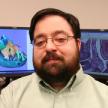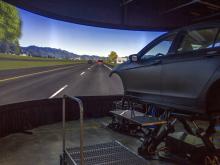Ed.—This post is the fourth in a series on manufacturing in recognition of Ohio Manufacturing Month (October) and National Manufacturing Day (Oct. 4). For others in this series, follow the manufacturing tag.
Just a year after the opening of the Driving Simulation Laboratory, the facility is demonstrating the successes that can be achieved through collaboration between public educational institutions and industry. The lab is a partnership between The Ohio State University, Honda R&D Americas and the Ohio Supercomputer Center.
Our facility houses three separate simulators:
- A fully immersive simulator, including a six degree-of-freedom motion base, which allows motion in three directions and rotation around three axes. This simulator features a 260-degree cylindrical screen, a separate screen for the rear view mirror, side view mirrors simulated with LCDs, external and internal speakers, and a force-feedback enabled steering wheel.
- A drive-on simulator, where vehicles can be placed and hooked into the simulation system. Accelerometers are attached to the pedals to detect user breaking and accelerating. The car rests on turntables with optical sensors, recording information about wheel position and, therefore, steering.
- A desktop simulator that can be used for early investigation with bench prototypes, as well as employed as a workstation for rapid development of new simulation scenarios.
This diverse group of simulators provides multiple options for industrial clients. The drive-on sim allows industry partners to gather data on prototype vehicles in the design phase and also to investigate the performance of competitor vehicles. The motion-base simulator can provide a more immersive experience in testing prototype parts that can be retrofitted into an existing car.
In the same way as simulation in high performance computing requires a merging of physics, math and computer science, real-time simulation is a complex field, involving human factors, computer science, mechanical and electrical engineering, psychology and cognitive science. The list of fields making use of real-time simulation is just as diverse. Along with our primary collaboration with Honda R&D, we have had interest from both the industrial and academic realms, including other auto manufacturers, Tier-1 suppliers of auto components, and researchers in optometry, psychology and industrial design.
This year, we also hosted a lab session for an Ohio State Mechanical Engineering course in vehicle dynamics. Hands-on experience with a simulation coupled with the ability to analyze data from a driving run personally experienced by the student generates skills that are vital for work in industry.
We will be accelerating our work into the next year with a recent grant award from the U.S. Department of Transportation for a University Transportation Center. The center is a collaborative program involving the Driving Simulation Lab, the Ohio State Center for Automotive Research, the Ohio State College of Engineering and other universities. The project will focus on research involving crash-imminent scenarios, which are critical for the further development and adoption of autonomous and semi-autonomous driving systems, which is quite possibly the next major dramatic shift in the automobile industry.



